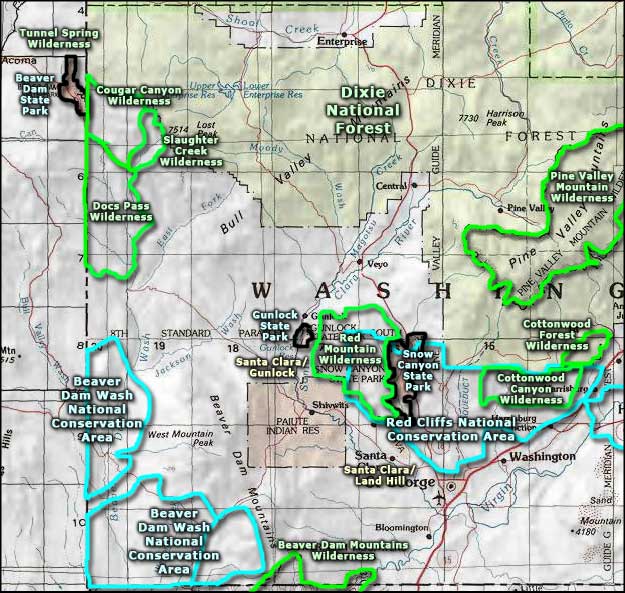Beaver Dam Wash National Conservation Area

Beaver Dam Wash National Conservation Area

Beaver Dam Wash National Conservation Area occupies about 68,000 acres of property in the corner of Utah against Nevada and Arizona. US Highway 91 is the only paved road to cross the Beaver Dam Wash NCA. Motor vehicle access on the property is limited to existing roads and some of the existing roads are barricaded to further reduce the impact on the property. Even Off-Highway Vehicles are restricted to the designated allowed roads.
Beaver Dam Wash National Conservation Area lies on the boundary where the Mojave Desert meets the Great Basin. That means the vegetation in the lower areas is mostly a mix of Joshua tree, white bursage, creosotebush and desert shrubs. The lower habitats are excellent for the growth of the Mojave Desert tortoise, a species listed among the federal threatened and endangered species. Higher elevations offer a few larger Joshua trees mixed with dense stands of blackbrush.
The upper reaches of Beaver Dam Wash sometimes see surface water flow but only extremely rarely does water reach all the way to the boundary of the property before disappearing into the ground. However, there are threads of riparian vegetation along some of the channels that do see some amount of water flow.
The closest thing to a developed facility on the property for the accommodation of human visitors is perhaps the road into Joshua Tree National Natural Landmark. The designation of Beaver Dam Wash as a National Conservation Area just happened in 2009 and these things take time...

Mojave Desert Joshua Tree Road Scenic Backway sign

Incorporated into the Beaver Dam Wash National Conservation was the 1,015-acre Joshua Tree National Natural Landmark, a site in the heart of a several-thousand-acre Joshua tree forest, the only Joshua trees that try to live in Utah. Before 2009, this National Natural Landmark also lived as part of a Wilderness Study Area but was incorporated into the NCA because it was felt that designation was enough to protect the valuable vegetation in the area: Joshua trees, Utah agave, barrel cactus and Johnson's Fishhook cactus with their accompanying animal lifeforms: Gila monsters, kit fox, Gambel's quail and Mojave Desert tortoise. The National Natural Landmark designation was given in 1969 but wildfires in 1993 and 2006 have drastically changed the landscape and distribution of the vegetation: there are very few Joshua trees left alive within the landmark boundary. These days, you'll see more Joshua trees along the road than in the back country.
Some threads of the Old Spanish Trail also crossed the Mojave Desert in this area of Utah, mostly following the route now known as US Highway 91.

Near Joshua Tree National Natural Landmark

In the backcountry of Beaver Dam Wash National Conservation Area
Click on any of the images below to see a larger version:

Map of the Beaver Dam Wash National Conservation Area
Shaded map courtesy of the Bureau of Land Management






